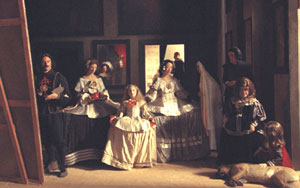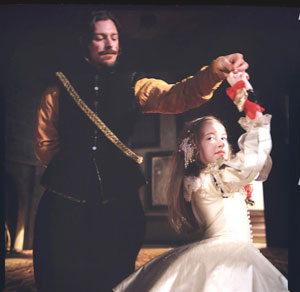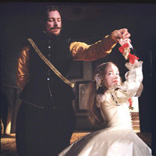There is a moment in the film documenting the making of Eve Sussman’s captivating video, 89 Seconds at Alcázar, when the artist turns to the actor playing Diego Velázquez and says, “You’re very confident, very relaxed. You’re just in it. You’re just making this painting.”
It is a telling scene. Sussman clearly has an intuitive understanding of the 17th-century artist. Velázquez, at least as he chooses to portray himself in Las Meninas, the monumental work on which 89 Seconds is based, seems to radiate calm as he dabs paint on an immense canvas, quietly engineering his place in history (and the Spanish court) all the while surrounded by the chaos of people going about their lives. Indeed, he is barely fazed by what appears to be the “royal epiphany” — the king and queen entering his studio.
But the two artists share more than the gift of being calm at the center of a storm. Sussman calls herself a “sculptor who makes films,” and by the same token, Velázquez, who helped remodel the palace, could be considered an architect who made paintings. “Documents show that during the 1650s,” wrote art historian Jonathan Brown, “Velázquez was more occupied with architecture than with painting.” Measuring approximately 10 by 9 feet, Las Meninas is huge. Similarly, as it is installed at Rice, 89 Seconds is an enveloping experience. Not only is the projection breathtakingly large, the sound is incredibly precise. The creaky, eerie score, composed by Jonathan Bepler, known for his work on Matthew Barney’s Cremaster films, contributes to the overall effect. During more than one viewing I was compelled to turn around and look behind me, only to find that what I had believed to be the rustle of someone entering the gallery in fact signaled the arrival of a sumptuously gowned maid onto the screen.
An artist I know told me she thinks 89 Seconds has “too many tricks.” It is a strange accusation. For one thing, Las Meninas is also guilty of “tricks,” since the mirror that apparently reflects the king and queen would be an optical impossibility in real life. But the comment keeps coming back to haunt me. Sussman’s next project is a video based on Jacques-Louis David’s Rape of the Sabine Women. Part of me can’t wait to see what she’ll do with this material — the part of me that has always been obsessed with mythology, archetypes, and story. Another part of me wonders if maybe it’s a problem for Sussman to become known as “the-artist-who-turns-great-masterpieces-of-Western-art-into-video.” When I saw 89 Seconds at the newly renovated Museum of Modern Art in New York City (the installation is pathetic compared to the one at Rice) I overheard someone say that the work reminded them of the paintings in Harry Potter’s boarding school, Hogwarts: the ones that come to life and talk to you. O.K., it is a silly observation, but it says a lot. I think it is great for a work to have the kind of magic that lures people in and makes them want to stay for a while. However, too much can have a lulling effect. Someone might be tempted to look behind the curtain, to discover that what they thought was magic is really just a series of tricks.
Images courtesy the artist and Rice University Art Gallery.
Claire Barliant is a critical studies fellow at the Core Program.





